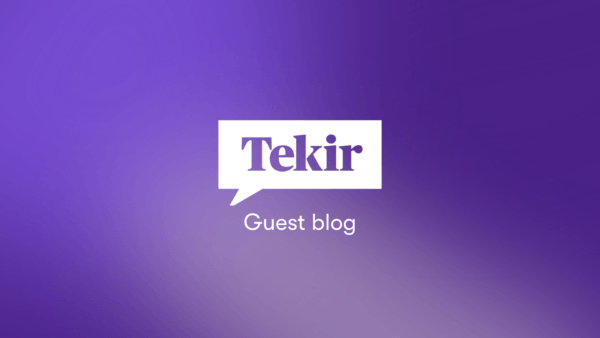
The future of leadership: co-creation is replacing top-down management
It’s time for a paradigm shift for leaders. But first, let’s paint a picture of you sitting down to work on a Monday morning.
Scenario 1
Stretching with a cup of coffee in hand, you sit down at your “desk” at home. An involuntary yawn escapes as you log in to your computer. You roll your shoulders and adjust your neck to try and relax some tension.
With the right numbers at the ready—and defenses too since last week was a dumpster fire—you start your weekly Zoom call with your manager. If you’re lucky, she’s okay with keeping the video off during the call this morning.
The meeting opens in the typical way: “Hey what’s happening? Did you have a good weekend?” You’ve exchanged the necessary pleasantries, so now it’s time to start drilling down the numbers and comparing them to the top-down OKRs.
Typical questions arise: She asks about how your tasks are progressing then tells you how you should proceed. “I did a bit of thinking last week and I feel it’s better to pivot our focus here. Can you start working on this already this week?”, and “Have you seen the updates to the OKRs?”
Before the meeting ends, your boss tells you about some of the games and activities she has planned for the whole team this coming Friday afternoon. She seems pretty excited about it.
And that’s it. Now you might have some time for your individual tasks before you head to your next meeting with a different manager.
Scenario 2
Now what if things went a little differently?
Your morning still starts with the typical stretch, coffee, and yawn but your weekly sprint meeting with your team includes questions like: “How happy do I feel about the last sprint?”, “How well did I recover?, “How is your work progressing?”, “Do you feel you need any help?”, and “What do you think is your main bottleneck at the moment?”. It’s a part of a reflection process you created together to help you learn from each other and ensure well-being.
Discussions are done collaboratively. OKRs were set collaboratively and in the meeting you reflect on them and the big picture together.
You might still feel drained after intensive meetings. Zoom fatigue is real, folks. However, you have a greater sense of purpose. Your role has greater autonomy and responsibility. You get to decide how to organize your days and weeks.
You feel more engaged and invested in the company because you helped set the goals. Together with the team, you plan fun leadership activities to build trust and understanding.
So, if it wasn’t already painfully obvious, this article is championing the second scenario where the manager doesn’t simply give instructions, but involves the whole team in decision-making. Because at Howspace, we believe the future of work is social—this means leadership needs to evolve with it.
Moving away from the top-down approach to leadership
Leadership has already started to change and it is no longer widely considered as position-based. This means management is not a prerequisite for leadership and managers are not necessarily leaders.
However, many organizations today still view leaders and managers as the main disseminators of knowledge and skills. They are seen to have the best means and expertise to measure productivity and ensure a team’s success.
Building a team’s skills generally starts from the position: What can the manager do to build engagement and skills? This leads to a plethora of blogs recycling the same leadership group activities and “fun” leadership games.
But the pandemic has helped to shift perceptions. As Deloitte stated in their recent 2021 Global Human Capital Trends, “We’ve lived in a world where we assumed organizations knew best what skills workers needed to bring to the table. But the pandemic taught us that potential comes to fuller fruition when workers are allowed to take more initiative.”
45% of global executives see the importance of building an organizational culture that celebrates growth, adaptability, and resilience to transform work. While another 35% see the importance in building workforce capability through upskilling, reskilling, and mobility.
Companies should empower their employees to “reimagine what, how, and where work gets done.” This requires leaders to expand their scope beyond what they can directly control.
Circle of influence vs. circle of control
Stephen Covey popularized the concept of two spheres: circle of concern and circle of influence, in his book 7 Habits of Highly Effective People (1989).
The circle of concern, which includes the elements that cannot be directly or indirectly influenced, is widely seen as counterproductive for all individuals. Your worry only brings you more stress in your work and everyday life.
The circle of influence includes those elements we can directly or indirectly influence. This is the sphere where individuals can be the most proactive.
A final sphere is often connected to Covey called the circle of control. However, this concept was not included in his original book. It was actually his son, Sean Covey, who wrote about it in his book 7 Habits of Highly Effective Teens (1998), which simplifies his father’s original concept for a younger audience. Sean Covey only distinguishes between control and no control.
The circle of no control includes elements of life we cannot change like parents, past mistakes, where you were born, skin color, etcetera.
The circle of control focuses on the elements we can affect like our choices, responses, and attitude.
It is important to note the second concept does not discuss elements that you can have influence over but cannot control.
Over time, it seems these two different concepts have become conflated. However, it presents an interesting starting point to discuss the difference between control and influence in leadership.
Traditionally, leaders have been encouraged to implement a top-down approach to leadership. This is where you have the most “control” over your direct environment. The reality is, however, you are in direct control only over your own behaviors.
A skilled leader today understands that you can influence other people’s behaviours indirectly, by different interventions for instance, but that you also need to involve others in the leadership process. By involving others, you tap into their basic human needs, and they will become more inclined to collaborate and to share their knowledge and experience.
Focusing only on the elements that you can directly control limits your personal effectiveness (and your team’s) because you ignore partnerships or alliances out of your sphere. A team as a whole can have a wider circle of influence than just a single individual.
Additionally, when we place more emphasis on our sphere of influence and the elements our whole team can affect, we also find that the sphere begins to increase—for everyone.
The more people are encouraged to activate and expand their own spheres of influence, the healthier the company will be because it promotes greater autonomy and engagement.
How can we ditch the top-down leadership approach?
This isn’t an easy question and we don’t presume to have all the answers, but it needs to start at a very fundamental level.
When we think of team building skills, we often focus on communication, active listening, problem solving, critical thinking, teamwork, and trust.
However, we tend to ignore the even more fundamental, human elements of the skills above. For example, to be an active listener, you need to have qualities of humility and empathy.
Now it’s quite easy to say that people should develop these qualities, but it’s an entirely different thing to actually foster them in yourself—let alone others.
So, the recommendation is to start with your team. Pose the question to them: what skills are necessary for building a strong, effective team? Try to find some answers together that work for you and your company. The skills necessary for building a team should be defined by your team collaboratively regardless of position.
If you engage the team in discovering what skills are needed to reach their common goals, they are more likely to sincerely contribute to actualizing these skills.
Finally, it’s important to remember that a leader doesn’t need to know all the answers. You do not have to be the sole expert in your team or company. The ability to say “I don’t have the answer and let’s work together” is key to building a truly collaborative team.
This requires a level of vulnerability that will most likely need to be developed just like the other human elements of humility and empathy.
Of course, you can’t always lead with “I don’t know” because your team needs to be able to trust your knowledge and abilities, but perfectionism is a toxic trait.
Activating your team’s sphere of influence will ensure a greater road to success together when you allow yourself to also be a team player rather than only a “leader.” Your employees’ circle of influence increases as they become more actively engaged. They understand how they can make a difference in their own work life.
Ensure your actions reflect your words
It’s also crucial that your words match your actions. Managers can often conflate what they say and do. For example, “I trust what you’re doing, but here’s a new scoreboard I’m introducing to measure your performance.” Or say “I really appreciate your input and I think that transparency and dialogue is important” but don’t actually take anything their employees have said into consideration. This disconnect or paradox is not an easy challenge for leaders to tackle.
Again, you need to start from the bottom—begin with your team. Build processes together. To make collaboration and co-creation a habit, it needs to be repeatedly practiced and re-enforced.
Building an effective and collaborative team is a marathon and not a sprint. One discussion, event, or webinar won’t do the trick. Make sure you are thinking of it as a continuous journey that evolves. Be open to it!
Get the right tools to help promote collaboration
If you’re thinking about developing greater collaboration between your team only using technology like Zoom or Microsoft Teams, chances are you’ll have a hard time. While video conferencing tools are needed, they’re not enough to enable ongoing and transparent collaboration between all participants.
Howspace also enables a seamless blend of synchronous and asynchronous learning and collaboration (because meaningful collaboration shouldn’t be strictly either/or), which allows for greater freedom to choose when, where, and how you work together.
Interested in exploring Howspace further? Start for free today and gain access to a suite of interactive tools designed to introduce collaboration to your daily ways of working.
You might be interested in these as well
View all
The modern transformation leaders’ imperative: creating engagement and enabling meaningful conversations
Antti Miettinen’s guest blog explores the changing dynamics of leadership in 2023, emphasizing adaptability and resilience.

How shared purpose drives collaborative workplaces
Today’s world of work is purpose-led, and workers expect employers to deliver.

Why collaboration & improved ways of working are crucial for the future of work
The world of work is at a crossroads: Since the pandemic, leaders have focused on transforming the workplace, yet employees […]